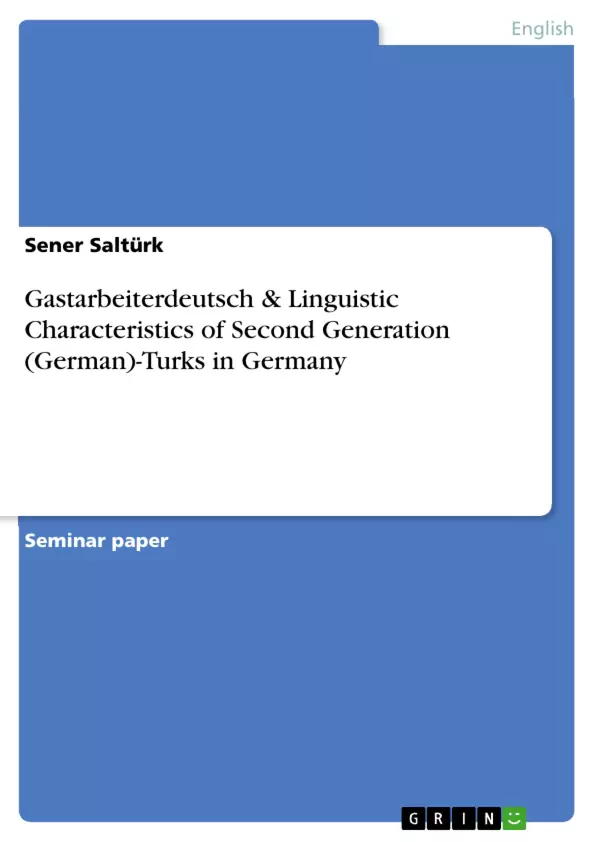[...] Their children, the (so-called) second generation who were mostly
born in Germany had a not so fundamentally different relationship to Germany which is
actually supposed to be their home country. There are, however, some vast differences
between these generations, especially in terms of their German language proficiency. Most of
the second (or third/fourth) generation of Gastarbeiter today are bilingual speakers, generally
more fluent in German than in the respective language of their parents. Of course, these
generations share more “distinctive” features than sole linguistic ones: the majority of the
guest workers’ children are, in full contrast to their parents, in many ways integrated into
German society and do have a much closer relationship to Germany as a whole. Whereas
most Germans are monolingual, speaking “some” (more or less acceptable) English or French
or Italian etc., the Germans (!) with foreign descent have two languages at their disposal –
whether they succeed in both languages (or in either of them!) is, of course, another question,
many of which, however, can be tackled using a socio-linguistic approach. For the purpose of this paper I shall focus on some linguistic phenomena of
Gastarbeiterdeutsch, not only referring to the (highly restricted) German language proficiency
of the first generation of Turkish guest workers (circa 1960-1975) but also on their offspring
(circa 1975-). Since I am of Turkish descent myself –my father, a guest worker himself, had
his “first shift” in a German coal-mine in August 1965- I have been (and still am) dealing very
closely with the language-related particularities (and oddities) of a Turkish dominated
parents’ house somewhere in North Rhine-Westphalia. In order to explain these, to my mind,
one has to investigate profoundly the linguistic “equipment” of the respective speakers
alongside with their “social whereabouts” and the country they immigrate to and where they
live, especially the linguistic “challenges” they have to face. For this purpose, a comparative
analysis of Turkish and German is indispensable. Since it goes without saying that an
elaboration on all of these aspects would undoubtedly go beyond the scope of this paper, I
shall concentrate on the language equipment of the “first generation Turks” and their children,
specifically on code-switching phenomena. What is required in the first place, I think, is an
overall outline of both Turkish and German, especially of Turkish.
Inhaltsverzeichnis (Table of Contents)
- I. Introduction
- II. Origin of the Turkish Language
- III. Typology of Turkish
- IV. Social Factors / Circumstances
- V. Linguistic Analysis of Gastarbeiterdeutsch – Selected Example
- VI. Gastarbeiterdeutsch – A Pidgin?
- VII. German Language Use of Second Generation Turks in Germany
Zielsetzung und Themenschwerpunkte (Objectives and Key Themes)
The paper aims to analyze the linguistic characteristics of Gastarbeiterdeutsch, a variety of German spoken by Turkish guest workers and their descendants in Germany. It focuses on the language proficiency of both first and second generation Turks, highlighting the social and cultural factors that have shaped their language development.
- The linguistic features of Gastarbeiterdeutsch
- The role of social factors in shaping language acquisition
- The influence of Turkish on German language use
- Code-switching phenomena in bilingual speakers
- The relationship between language and identity
Zusammenfassung der Kapitel (Chapter Summaries)
- I. Introduction: The paper introduces the concept of Gastarbeiterdeutsch and its historical context. It discusses the social and cultural background of Turkish guest workers in Germany and their impact on German language use.
- II. Origin of the Turkish Language: This section provides a brief overview of the origin and development of the Turkish language, tracing its roots back to the Turkic language group and its potential connection to the Altaic language family.
- III. Typology of Turkish: This chapter examines the typological features of Turkish, contrasting its grammatical structure with Indo-European languages. It highlights key characteristics such as the absence of grammatical gender and the use of agglutination.
- IV. Social Factors / Circumstances: This section explores the social and cultural circumstances that influenced the language acquisition of Turkish guest workers in Germany. It analyzes factors such as their educational background, their intentions for staying in Germany, and the German societal context.
- V. Linguistic Analysis of Gastarbeiterdeutsch – Selected Example: This chapter presents a detailed analysis of a transcribed conversation between a Turkish guest worker and a researcher, highlighting common linguistic features of Gastarbeiterdeutsch, such as verb placement, article usage, and code-switching.
- VI. Gastarbeiterdeutsch – A Pidgin?: This section discusses the question of whether Gastarbeiterdeutsch can be classified as a pidgin, examining the characteristics of pidgin languages and comparing them to the features of Gastarbeiterdeutsch.
Schlüsselwörter (Keywords)
The paper examines the linguistic characteristics of Gastarbeiterdeutsch, focusing on code-switching, bilingualism, second language acquisition, and the social and cultural factors that influence language development in the context of migration. It also explores the concept of pidgins and their relevance to the study of Gastarbeiterdeutsch.
- Quote paper
- StR Sener Saltürk (Author), 2006, Gastarbeiterdeutsch & Linguistic Characteristics of Second Generation (German)-Turks in Germany, Munich, GRIN Verlag, https://www.grin.com/document/204007



